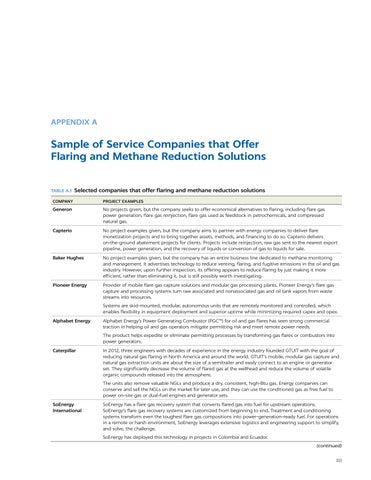APPENDIX A
Sample of Service Companies that Offer Flaring and Methane Reduction Solutions TABLE A.1
Selected companies that offer flaring and methane reduction solutions
COMPANY
PROJECT EXAMPLES
Generon
No projects given, but the company seeks to offer economical alternatives to flaring, including flare gas power generation, flare gas reinjection, flare gas used as feedstock in petrochemicals, and compressed natural gas.
Capterio
No project examples given, but the company aims to partner with energy companies to deliver flare monetization projects and to bring together assets, methods, and financing to do so. Capterio delivers on-the-ground abatement projects for clients. Projects include reinjection, raw gas sent to the nearest export pipeline, power generation, and the recovery of liquids or conversion of gas to liquids for sale.
Baker Hughes
No project examples given, but the company has an entire business line dedicated to methane monitoring and management. It advertises technology to reduce venting, flaring, and fugitive emissions in the oil and gas industry. However, upon further inspection, its offering appears to reduce flaring by just making it more efficient, rather than eliminating it, but is still possibly worth investigating.
Pioneer Energy
Provider of mobile flare gas capture solutions and modular gas processing plants. Pioneer Energy’s flare gas capture and processing systems turn raw associated and nonassociated gas and oil tank vapors from waste streams into resources. Systems are skid-mounted, modular, autonomous units that are remotely monitored and controlled, which enables flexibility in equipment deployment and superior uptime while minimizing required capex and opex.
Alphabet Energy
Alphabet Energy’s Power Generating Combustor (PGC™) for oil and gas flares has seen strong commercial traction in helping oil and gas operators mitigate permitting risk and meet remote power needs. The product helps expedite or eliminate permitting processes by transforming gas flares or combustors into power generators.
Caterpillar
In 2012, three engineers with decades of experience in the energy industry founded GTUIT with the goal of reducing natural gas flaring in North America and around the world. GTUIT’s mobile, modular gas capture and natural gas extraction units are about the size of a semitrailer and easily connect to an engine or generator set. They significantly decrease the volume of flared gas at the wellhead and reduce the volume of volatile organic compounds released into the atmosphere. The units also remove valuable NGLs and produce a dry, consistent, high-Btu gas. Energy companies can conserve and sell the NGLs on the market for later use, and they can use the conditioned gas as free fuel to power on-site gas or dual-fuel engines and generator sets.
SoEnergy International
SoEnergy has a flare gas recovery system that converts flared gas into fuel for upstream operations. SoEnergy’s flare gas recovery systems are customized from beginning to end. Treatment and conditioning systems transform even the toughest flare gas compositions into power-generation-ready fuel. For operations in a remote or harsh environment, SoEnergy leverages extensive logistics and engineering support to simplify, and solve, the challenge. SoEnergy has deployed this technology in projects in Colombia and Ecuador. (continued) 111


